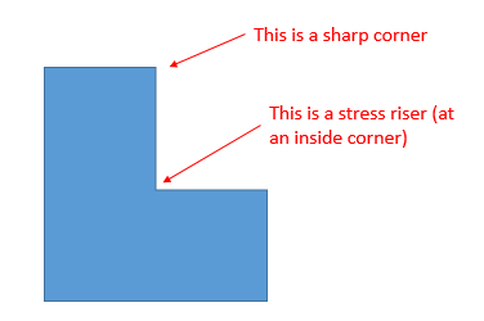Standard Notes
Standard Notes, otherwise known as General Notes, are usually located either above the title block or in the upper left corner of the drawing.
Standard notes cover many things. The notes below are a small subset of the things that standard notes can cover.
Standard notes can also be dangerous. It's easy to forget that they are there. This can lead to specifications on the drawing that are not consciously intended.
The notes below show standard notes for corners.
Standard notes cover many things. The notes below are a small subset of the things that standard notes can cover.
Standard notes can also be dangerous. It's easy to forget that they are there. This can lead to specifications on the drawing that are not consciously intended.
The notes below show standard notes for corners.
We need to clarify terminology and clarify where these notes do and do not apply.
First, I once got chastised by my supervisor when I was a designer and I used the terms "INSIDE CORNERS" and "OUTSIDE CORNERS" instead of "FILLETS" and "ROUNDS".
An "inside corner" generally receives a FILLET, and an "outside" corner generally receives a "ROUND".
It may be helpful to discuss why we do not want burrs or sharp corners (inside or outside). Burrs and sharp corners are safety hazards. Generally they cut people's hands.
Sharp inside corners cause stress risers. This causes parts to break.
First, I once got chastised by my supervisor when I was a designer and I used the terms "INSIDE CORNERS" and "OUTSIDE CORNERS" instead of "FILLETS" and "ROUNDS".
An "inside corner" generally receives a FILLET, and an "outside" corner generally receives a "ROUND".
It may be helpful to discuss why we do not want burrs or sharp corners (inside or outside). Burrs and sharp corners are safety hazards. Generally they cut people's hands.
Sharp inside corners cause stress risers. This causes parts to break.
Stress risers are relieved by fillets. Fillets cause the stresses in the part to become more spread out instead of getting concentrated at that one point.
Usually when we talk about corners, we are talking about an outside corner that is a 90 degree corner or sharper. Sharp corners are usually relieved by either a round or a chamfer. A round is shown below.
The other way of relieving a sharp corner is with a chamfer as shown below.
Note that the edges of a chamfer are not considered to be sharp corners and therefore do not need to be rounded.
Before rounding sharp corners, it's a good idea to think through the function of the part and maybe double check with the customer. Some sharp corners may be functional, and it would be easy for a designer to forget that a general note is telling the supplier to round that corner.
A little bit of extra communication, especially when it comes to standard notes, can save a lot of scrap!
A little bit of extra communication, especially when it comes to standard notes, can save a lot of scrap!






